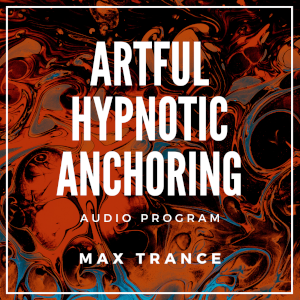A hypnotic trigger is something that a hypnosis subject can perceive that causes them to automatically and unconsciously do something else. Hypnotic triggers are created either by giving the subject a direct instruction while they are in hypnosis, or by causing the trigger to happen immediately before the thing it will trigger. The latter form is usually known as a hypnotic anchor.
Anchors can be literally anything at all that the subject can perceive, including things they can see, sounds, smells, specific touches, and even their own thought patterns.
Triggers tend to be more along the lines of a specific spoken word or phrase.
And in practical terms, you can use the words interchangeably. I tend to prefer to use the word anchor because it feels more true to the way that I tend to use hypnotic anchors.
Either is better though, and when you’re starting out, it’s often easiest to think about them as simple triggers that cause someone to do something.
What is a hypnotic trigger?
From our perspective as hypnotists, the human brain does only one thing: It associates stuff with other stuff. Hypnotic triggers are formed when we intentionally cause one of these associations to be something we can control. Then when we experience that thing, our brain will conveniently recall whatever we’ve associated with it.
This process is constant and automatic and it forms the framework through which we make sense of the world.
If you’d like to know more about how all of that works, check out my article on how human memory works with hypnosis.
Types of hypnotic trigger
Hypnotic triggers can be both overt and covert.
Overt triggers are those where the hypnosis subject can observe what the hypnotist did, and consciously figure out what’s going on. An example of this is when the hypnotist blatantly tells the subject exactly what to do, like when they are given the direct instruction to go into deep hypnosis when they hear the word SLEEP.
Covert triggers are the ones where even some hypnotists might not be able to spot what’s going on. An obvious example that most people overlook is when we smile and nod to help build an agreement frame. These are usually known as hypnotic anchors.
Overt triggers tend to work brilliantly when the subject is fully onboard with the purpose of the trigger. This includes things like going into hypnosis, most things you might do for fun, and also pretty much anything where the long term effects won’t matter much.
Covert triggers tend to be more effective than overt in cases where there is some disconnect between the subject’s conscious and unconscious minds.
So which should you use?
If you’re starting out, doing things for fun, or just doing something simple, use overt hypnotic trigger words. And if you are helping someone to make permanent changes, or are a more experienced hypnotist, use anchors.
How to create hypnotic triggers
To create a hypnotic trigger, hypnotize the subject then give them a direct instruction along the lines of every time you hear me say the word SLEEP for the next hour, you will immediately return to a deep hypnotic trance, twice as deep as ever before. Alternatively, perform the trigger immediately before the thing you’d like it to cause.
The creation of hypnotic triggers is a learning process. And as with other learning processes, it tends to be a good idea to repeat things several times if we want them to stick.
Often we’ll also want to do things to give us the best possible chance of having our trigger words work in the future.
Here are the steps for creating an overt hypnotic trigger:
1. Hypnotize your subject
If we want our subject to respond to a hypnotic trigger, it’s important to hypnotize them first. Skip this step, and our subject will be completely free to simply throw out our suggestion.
You can hypnotize people using any induction at all for this part.
2. Describe what the hypnotic trigger will do
For all but the simplest triggers, it’s helpful to describe exactly what the trigger will do before you create it. This allows the subject to form an image of it in their mind. That way, when you set up the trigger words, you can reference the image they already have.
If you are starting out, the first trigger words you will want to play with will probably be along the lines of GO DEEP NOW or something very similar. This specific one has a huge advantage in that they’re already in hypnosis, so you don’t have to describe it.
3. Create the trigger
To create the trigger, make statements like every time you hear me say the phrase GO DEEP NOW and it’s safe and appropriate to do so, you will return to a wonderful state of deep, blissful hypnosis, twice as deep as ever before.
Riff around the basic idea and be sure to repeat the hypnotic trigger words at least three times.
Make sure that you localize the trigger in some way so that it cannot fire at times when it would be bad if it did. For example, you do not want someone suddenly going into deep hypnosis while they are operating machinery.
This is handled by the phrase and it’s safe and appropriate to do so above.
4. Bring your subject out of hypnosis
As you bring your subject out of hypnosis, remind that them the trigger words will always work automatically now and remind them what those words are.
It looks something like this: And from now on, every time you hear me say the phrase GO DEEP NOW you will immediately return to a wonderful state of deep hypnosis, twice as deep as ever before, exactly as we’ve discussed. And you know exactly what that’s like, don’t you.
5. Check in with your hypnosis subject
While they are still in the trance afterglow, take a few moments to reinforce that your subject had an amazing time. Go to town on helping them to feel good.
Then invite them to test.
6. Test the hypnotic trigger phrase
To test the hypnotic trigger words, simply ask your subject if they’re ready.
If it’s a more complex state, remind them of what it was like a bit first. In the case of our GO DEEP NOW trigger, talk a little bit about what it’s like being in hypnosis.
It looks something like this: Now I don’t know if you remember what it was like being in hypnosis, when you had that wonderful blissful, calm, drifting peacefully and everything seems so clear now. Are you ready to go back to that state now? [Wait for them to indicate readiness.] GO DEEP NOW.
7. Turn off the trigger
Whatever hypnotic trigger you installed, usually you will want to turn it off at the end of the session. In the case of our GO DEEP NOW trigger, we bring them out of hypnosis again in the same way as before.
Also, when installing a trigger to send someone into hypnosis, it’s often helpful to install another one that will bring them out of hypnosis again. This is done in exactly the same way: Outline the process for coming out of hypnosis, then tell them that every time they hear you say the trigger, they will immediately come out of hypnosis following that process.
How to use hypnotic triggers
To use a hypnotic trigger, spend a few moments reminding the hypnosis subject what the trigger does, ask them if they’re ready, then fire the trigger.
As a rule of thumb, it’s only necessary to describe what the hypnosis trigger does the first few times it is used, and only if it fires up a significantly different state.
For example, if you were making someone act like a kitten, you might remind them how a kitten thinks and behaves before firing the trigger.
Most of the time all you have to do is say the hypnotic trigger words, or in the case of a covert trigger, cause your subject to experience it, and the associated pattern will fire up.
If you’ve installed the trigger words GO DEEP NOW, simply speak that phrase and continue right on with your deepener and the rest of your hypnosis session.
It’s usually best to ask your hypnosis subject if they’re ready before you fire any triggers.
And naturally, if you are on an audio call or interacting with your subject online, make sure you check that they’re not doing anything where firing the trigger could have unintended consequences.
Whatever your trigger does, return your subject to normal at the end of the session. If you’ve made long-term changes, you can make a statement along the lines of: bringing with you any changes that will be beneficial for you in the future, making those permanently a part of you now.
Hypnotic anchors
Simple hypnotic triggers are fantastic when you’re starting out with hypnosis. They’re even useful when you’re more experienced as a way to quickly and reliably get people into trance.
And it’s possible to go much further with them. The truth is that when we want to become skilled at hypnosis, effective anchoring is one of the most important skills for us to develop.
Hypnotic anchors and hypnotic triggers are really the same thing.
Beyond what we’ve covered here, anchors can be used for just about everything from helping us to recall things, through shaping and even changing people’s behaviors, modifying their thought patterns, and much more.
Not only that, there are simple things we can do to make our hypnotic anchors much more effective.
As you might imagine, anchoring is a huge topic. In fact, it’s so huge that I’ve written a short book on it.
I’ve designed the book from the ground up to take people from not even knowing what an anchor is to being able to set and use them with ease.
And I’ve included important details such as why anchors can degrade over time, and what to do to prevent that.
Now, I hate it when I read a book and the author takes 300 or more pages to say something they could just as easily have said in 10. So I’ve tried to leave out all the fluff and include only the things you actually need.
If all of that sounds like something you’d like to have happen, go and check out my book Artful Hypnotic Anchoring and you can get started right away!





